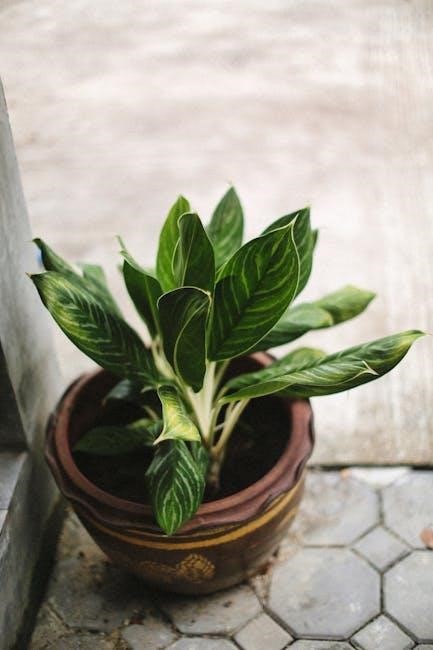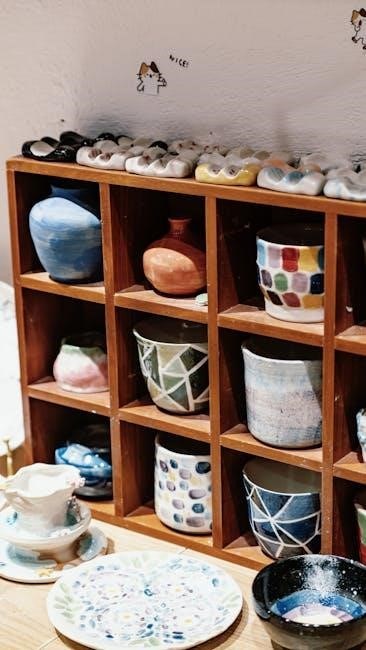McCoy pottery’s value is determined by rarity, condition, age, and authenticity. Rare pieces like limited editions and specific designs command higher prices due to strong collector demand.
McCoy Pottery, an iconic American ceramics brand, has captivated collectors with its unique designs and craftsmanship since the late 1800s, blending artistry and functionality.
1.1 History of McCoy Pottery
Mccoy Pottery, founded by J.W. McCoy in 1899 in Roseville, Ohio, became a cornerstone of American ceramics. The company grew steadily, producing iconic pieces under the guidance of Nelson McCoy, who played a pivotal role in its success. By the mid-20th century, McCoy Pottery was renowned for its artistic designs and high-quality craftsmanship. The company ceased operations in 1990, leaving behind a legacy of timeless ceramic art cherished by collectors worldwide.
1.2 Popularity Among Collectors
Mccoy Pottery’s enduring appeal lies in its unique designs, vibrant colors, and timeless craftsmanship. Collectors admire its nostalgic value, with many pieces evoking memories of past eras. The pottery’s versatility, ranging from functional items to decorative art, broadens its allure. Rare and limited-edition pieces are particularly sought after, driven by their historical significance and aesthetic charm. This blend of artistry and nostalgia makes McCoy Pottery a favorite among both seasoned and new collectors.
Factors Affecting the Value of McCoy Pottery
Factors affecting McCoy Pottery’s value include rarity, demand, condition, and age. These elements significantly influence its worth in the collector’s market.
2.1 Rarity and Demand
Rarity and demand significantly influence McCoy pottery’s value. Limited editions and specific designs, such as the banana bunch pattern, are highly sought after by collectors. The historical legacy of McCoy, dating back to 1899, further enhances its appeal. As demand outpaces supply for certain pieces, their value increases, making rare McCoy items highly prized in the collector’s market.
2.2 Condition and Age
Condition and age are critical factors in determining the value of McCoy pottery. Pieces in pristine condition, without chips, cracks, or heavy wear, command higher prices. Age also plays a significant role, with older pieces from the early 20th century often being more valuable. Even minor damage can drastically reduce a piece’s worth, emphasizing the importance of preservation; Collectors prioritize well-maintained, vintage items, making condition and age key determinants of value.
2.3 Authenticity and Provenance
Authenticity and provenance significantly impact the value of McCoy pottery. Pieces with verified McCoy marks or signatures are highly sought after, as they confirm the item’s legitimacy. Provenance, or the history of ownership, can further enhance value, especially if tied to notable collections or historical significance. Documentation and certificates of authenticity are crucial for verifying genuine pieces, ensuring they stand out in a market where counterfeit items exist.
How to Identify Authentic McCoy Pottery
Identify authentic McCoy pottery by examining its marks, signatures, and design patterns. Look for distinctive McCoy stamps or initials, and verify against known designs and historical records to ensure authenticity and value.
3.1 McCoy Pottery Marks and Signatures
McCoy pottery often features distinct marks and signatures, such as the “McCoy” name in a script logo or “McCoy USA,” which help verify authenticity. These marks, typically found on the base or underside, vary by production era. Early pieces may have simpler stamps, while later items include more detailed signatures. The presence of these marks is crucial for identifying genuine McCoy pottery and determining its value in the collector market.
3.2 Common Patterns and Designs
McCoy pottery is renowned for its artistic and functional designs, often featuring nature-inspired motifs like floral patterns, leaves, and geometric shapes. Popular patterns include the iconic “Brush McCoy” and “Banana Leaf” designs. Many pieces showcase hand-painted details and vibrant glazes, which contribute to their aesthetic appeal. These distinctive designs, combined with the pottery’s craftsmanship, make McCoy pieces highly recognizable and sought after by collectors and enthusiasts alike.
3.3 Dating McCoy Pieces
Dating McCoy pottery involves examining marks, styles, and historical context. Early pieces often bear the “McCoy” stamp or “McCoy Pottery” mark, while later items may feature a backstamp with “McCoy ©” introduced in the 1930s. The company’s marks evolved over time, helping collectors pinpoint production eras. Pieces made after 1967 may include a date code, further aiding in identification. Understanding these dating cues is crucial for determining authenticity and value.
Where to Buy and Sell McCoy Pottery
McCoy pottery can be found at flea markets, antique shops, and auctions. Online platforms like eBay and specialized collectible forums also offer opportunities to buy and sell pieces.
4.1 Online Marketplaces
Online marketplaces like eBay, Etsy, and specialized collectible forums are ideal for buying and selling McCoy pottery. These platforms offer a wide audience, competitive pricing, and detailed product listings. Buyers can search for rare pieces, while sellers can showcase their items globally. Many platforms provide tools for comparing prices and researching sold items, helping both parties determine fair market value. High-quality photos and detailed descriptions are essential for successful transactions in these digital spaces.
4.2 Antique Shops and Auctions
Antique shops and auctions are excellent venues for discovering and purchasing McCoy pottery. These platforms often cater to serious collectors, offering rare and high-quality pieces. Auctions, in particular, can drive up prices for highly sought-after items due to competitive bidding. Buyers should inspect pieces carefully for condition and authenticity, and consider working with reputable dealers to ensure fair value and genuine McCoy pottery.
4.3 Flea Markets and Garage Sales
Flea markets and garage sales are treasure troves for discovering McCoy pottery. These venues often yield rare, overlooked pieces at bargain prices. Collectors can stumble upon hidden gems, but it’s crucial to inspect items for condition and authenticity. Negotiating prices is common, making these spots ideal for budget-conscious buyers. Patience and a keen eye can lead to exciting finds, adding unique pieces to your collection at affordable costs.

How to Research and Determine Value
Researching McCoy pottery value involves using price guides, eBay listings, and expert appraisals to determine authenticity and market worth accurately, essential for collectors and sellers alike.
5.1 Using Price Guides and Appraisals
Price guides and professional appraisals are essential for determining McCoy pottery’s value. These resources provide historical data, current market trends, and expert insights. Reputable platforms like WorthPoint offer detailed price guides, while appraisals from specialists ensure accuracy. By leveraging these tools, collectors can make informed decisions, ensuring their pieces are valued fairly and competitively in the market.
5.2 Checking Completed Listings on eBay
Checking completed eBay listings is a valuable method to assess McCoy pottery’s market value. By filtering search results to show only completed sales, collectors can determine what similar pieces have recently sold for. This approach provides real-time market data, helping to gauge demand and pricing trends. Use specific keywords and refine searches to find comparable items, ensuring accurate and relevant results to inform your valuation decisions.
5.4 Consulting with Experts
Consulting with experts is a reliable way to determine the value of McCoy pottery. Specialists in ceramics or antiques can provide detailed appraisals, verifying authenticity and assessing condition. They often have extensive knowledge of market trends and rare pieces. Reputable appraisers can be found through antique shops, auctions, or collector communities. Their insights help collectors and sellers make informed decisions, ensuring accurate valuations based on historical significance and demand.
Care and Maintenance of McCoy Pottery
Proper care involves gentle cleaning, avoiding harsh chemicals, and storing pieces in a cool, dry place. Handle with care to preserve condition and maintain value.
6;1 Cleaning and Restoration Tips
McCoy pottery requires gentle care to maintain its value. Use a soft, damp cloth to clean surfaces, avoiding harsh chemicals or abrasive materials; For stubborn stains, mix mild dish soap with warm water, but test on an inconspicuous area first. Avoid soaking or exposing pieces to extreme temperatures. Restoration should be handled by professionals to prevent damage. Regular dusting and proper storage in a cool, dry place are essential for preserving condition and longevity.
6.2 Storage and Display Recommendations
Store McCoy pottery in a cool, dry place, away from direct sunlight and moisture. Use acid-free tissue paper or soft cloth to wrap each piece. Display items on sturdy shelves or in glass-front cabinets to protect from dust. Avoid stacking pieces to prevent chipping or cracking. For long-term storage, consider using climate-controlled environments. Proper handling ensures preservation, maintaining the value and integrity of your McCoy collection for future generations.
McCoy Pottery as an Investment
McCoy pottery can be a wise investment due to its historical significance and growing collector interest. Pieces with rarity and provenance often appreciate in value over time.
7.1 Investment Potential
McCoy pottery holds strong investment potential due to its historical significance and aesthetic appeal. Rare and well-preserved pieces, especially those with unique designs or provenance, tend to appreciate in value. Collectors often seek high-quality, authentic items, driving demand and prices. While market trends can fluctuate, McCoy pottery remains a stable and rewarding investment for enthusiasts and serious collectors alike.
7.2 Trends in the Collector Market
Current trends show increasing demand for vintage and rare McCoy pottery, particularly pieces from the mid-20th century; Collectors are drawn to unique designs, limited editions, and items in exceptional condition. Online marketplaces have expanded accessibility, while auctions and specialized shops remain popular. The market also reflects a growing interest in historical ceramics, making McCoy pottery a sought-after collectible with steady growth in value and popularity among enthusiasts.

Top Valuable McCoy Pottery Pieces
McCoy pottery’s most valuable pieces include rare designs, limited editions, and items in pristine condition. A 1948-1952 banana bunch cookie jar, for example, is highly sought after and valuable.
8.1 Rare and Limited Editions
Rare and limited-edition McCoy pottery pieces are highly sought after by collectors. These items, often featuring unique designs or produced in small quantities, command premium prices due to their scarcity and historical significance. For instance, a 1948-1952 banana bunch pattern cookie jar is particularly valuable, reflecting the brand’s craftsmanship and timeless appeal in the collector’s market.
8.2 Most Sought-After Designs
Certain McCoy pottery designs are highly prized by collectors, such as the banana bunch cookie jar and floral patterns. These designs, known for their vibrant colors and intricate details, often fetch higher prices at auctions and sales. The popularity of specific patterns can vary over time, influenced by market trends and collector preferences, making them key pieces in any collection.

Regional Variations in Sales and Value
McCoy pottery’s value varies by region, with higher demand in areas like the Midwest and South, influencing sales and pricing dynamics across different markets.
9.1 Differences in Value Across the US
McCoy pottery values differ significantly across the US. Midwestern states, where the company originated, often see higher prices due to regional nostalgia and collector demand. Coastal regions may experience lower valuations as preferences lean toward modern or nautical themes. Southern states also show strong interest, particularly in classic designs, while Western markets tend to favor rare, unique pieces, influencing overall pricing dynamics nationwide.
9.2 International Market for McCoy Pottery
McCoy pottery’s international appeal is limited compared to its popularity in the US. While some global collectors appreciate its vintage charm, demand is lower, leading to generally lower valuations. European and UK markets show niche interest, particularly for rare designs, but prices often lag behind domestic sales. Cultural and advertising factors contribute to its lesser recognition abroad, though emerging collector communities in countries like Australia may drive future growth in international demand.
Using Technology to Aid in Collecting
Advanced search tools and online marketplaces simplify finding rare McCoy pieces. Digital communities and forums provide valuable insights, helping collectors identify and appraise McCoy pottery effectively.
10.1 Advanced Search Tools
Advanced search tools like Google’s filters and eBay’s completed listings help collectors pinpoint rare McCoy pottery. Using specific keywords and formulas, such as “value of first unit to second unit,” streamlines searches. These tools enable users to refine results by date, price, and location, making it easier to find and assess McCoy pieces. They also provide insights into market trends and pricing, aiding collectors in making informed decisions.
10.2 Online Communities and Forums
Online communities and forums are invaluable for McCoy pottery enthusiasts. Platforms like Reddit and specialized collector forums allow users to share discoveries, seek advice, and learn from experts. These spaces foster networking among collectors and provide insights into rare pieces and market trends. Engaging with these communities helps collectors stay informed and make informed decisions when buying or selling McCoy pottery.
Avoiding Counterfeit McCoy Pottery
Red flags for counterfeit McCoy pottery include mismatched marks and glaze inconsistencies. Verifying authenticity through expert appraisals ensures genuine pieces.
11.1 Red Flags for Fake Pieces
Identify counterfeit McCoy pottery by checking for mismatched marks, uneven glaze, and unrealistic weight. Genuine pieces typically have consistent base colors and precise signatures.
Fake pieces often lack the craftsmanship seen in authentic McCoy pottery, with poor reproductions of classic designs. Always verify authenticity through expert appraisals and provenance documentation.
11.2 Verifying Authenticity
Authentic McCoy pottery can be confirmed through detailed mark identification and historical research. Look for consistent signatures, dates, and style patterns aligned with known McCoy designs.
Consulting expert appraisers, referencing collector communities, and cross-checking with reputable databases are essential steps to ensure the piece is genuine. Provenance documents and certificates of authenticity can further validate its legitimacy.
Collector Communities and Resources
Join collector clubs and online forums to connect with enthusiasts, share knowledge, and access resources. Recommended books and guides provide valuable insights into McCoy pottery history and valuation.
12.1 Joining Collector Clubs
Joining collector clubs connects enthusiasts, offering networking opportunities, event participation, and access to resources. Members benefit from expert advice, authentication guidance, and insights into market trends. Active involvement enhances knowledge and collection growth, fostering a supportive community for McCoy pottery enthusiasts.
12.2 Recommended Books and Guides
Several books and guides are essential for McCoy pottery enthusiasts. Titles like The Collector’s Encyclopedia of McCoy Pottery and McCoy Pottery: The Ultimate Guide provide detailed descriptions, historical context, and valuation tips. These resources help collectors identify rare pieces, understand market trends, and make informed purchasing decisions. They are available through online marketplaces, antique shops, and specialty bookstores, offering invaluable insights for both newcomers and seasoned collectors.

The Future of McCoy Pottery Collecting
McCoy pottery collecting is expected to grow, driven by technology advancements and increased market visibility, making rare pieces highly sought after by enthusiasts and investors alike.
13.1 Emerging Trends
Emerging trends in McCoy pottery collecting include increased reliance on digital platforms for buying, selling, and researching pieces. Online marketplaces and social media are driving visibility and demand, especially among younger collectors. Additionally, there is a growing interest in sustainable and ethical collecting practices, with collectors prioritizing pieces with clear provenance. Advances in technology, such as AI for authentication, are also reshaping the market, making it more accessible and transparent for enthusiasts.
13.2 Predictions for the Market
The McCoy pottery market is expected to grow steadily, driven by increasing demand for rare and limited-edition pieces. Online platforms will continue to dominate sales, making collectibles more accessible. Younger collectors are showing heightened interest, ensuring long-term market vitality. Additionally, advancements in technology, such as AI for authentication, will enhance trust and transparency, further boosting the market’s appeal and value in the coming years.


